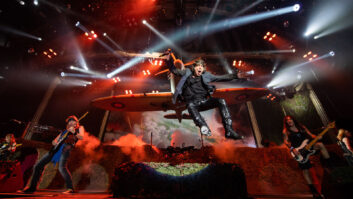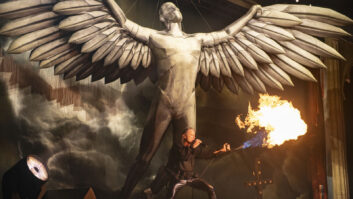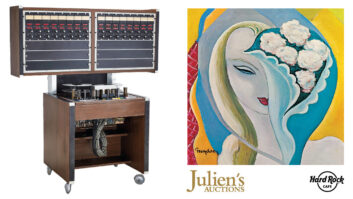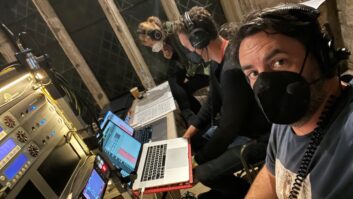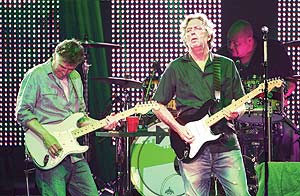
Steve Winwood (left) and Eric Clapton (center) perform alongside a stellar band, including drummer Abe Laboriel Jr. (right).
Photos: Steve Jennings
At first glance, it appears as if Robert Collins is sitting down on the job. After all, he’s been on the road with Eric Clapton for the past couple of decades and, well, the odds are that he’s heard it all by now. Yet the figure tucked into the leather office chair behind the DiGiCo D5 front-of-house board during this stop at Oracle Arena in Oakland, Calif., is doing just about everything but relaxing. His fingers are flying around the D5 adjusting levels, his toes are tapping and head bobbing, and, if you catch him at the right moment, he’s swearing at an EQ while trying to find a troublesome frequency.
The truth of the matter is that this tour is decidedly different for Collins, monitor mixer Kerry Lewis and the rest of the crew for a handful of reasons. The addition of Steve Winwood to this run of shows, as well as the inclusion of songs from Blind Faith, Traffic and the headliners’ catalogs has made this a special tour.
Perhaps the biggest difference, Collins is quick to say, is that this “tour” is only 14 shows in arenas across the States. That tends to quicken the pulse a bit. “A lot of big tours take a few shows to settle down, band included,” he says. “We haven’t got that many, so we’ve got to hit if off the bat.”
It’s not as if Collins and the crew had much time to worry about this tour; they were coming off 12 shows at the Royal Albert Hall in London with essentially a different band: drummer Abe Laboriel Jr., bassist Willie Weeks, Chris Stainton on keyboards, and background vocalists Michelle John and Sharon White. Laboriel Jr. has replaced drummer Steve Gadd; and Winwood, who played piano, organ and guitar, took over for guitarist Andy Fairweather Low and keyboardist Tim Carmon.
“We finished our last night in the Albert Hall, and the next morning we were straight on a plane to come to New York to set up for this band and do a week’s [worth of] rehearsing,” Collins says. “But there’s no more pressure than normal.”

Front-of-house engineer Robert Collins at the DiGiCo D5
Collins and Lewis are carrying their own consoles and are renting racks and stacks from Sound Image (Escondido, Calif.). The rig for all 14 shows is a JBL VerTec line array with 68 pieces of 4889 (14 in the main, 12 on the sides and eight for the back) and 16 4880 subs. An additional 10 QSC WideLine speakers were brought in. Crown I-T8000s power the boxes, and a HiQ System controls the amps. Collins relies on a simple set of outboard gear, including six Dolby Lake Contours, three dbx 162SLs for Clapton and Winwood’s vocals and a TC Electronic 6000 for reverb. A Midas XL88 and XL42 are used to get signal to the Smaart analyzers. Each show is archived through Steinberg Nuendo onto an AMD 96-track recording hard drive.
Tucked into stage-right behind Winwood’s organ, Lewis is busy managing the set of Clair 12AM wedges the band uses to monitor its sound, and the one personal monitor that Winwood uses to hear his vocals. “It’s not loud onstage,” he insists. “It’s a little more difficult because Steve has two Leslies onstage and I’ve got to compensate for those. If I put them at normal volume, it’s very loud and Eric can hear them. But I just stand in the middle of the stage when we check things in the afternoon and get a level.”
As far as the mixes that each bandmember calls for, Lewis points out those are straight-ahead. Clapton listens to most everything from other members’ amps — except the keyboardist and his acoustic guitar — and the drums. Winwood listens to vocals in one ear and gets a band mix in his wedges. Stainton gets a full band mix, while Laboriel likes to hear guitars, vocals and keyboards with no drums in his wedges. Weeks generally stands close to the drum kit to hear that naturally and gets a bit of bass drum for weight, as well as keyboards. Finally, the background singers hear keyboards, vocals and Clapton’s guitar.
Jumping to Digital

Monitor engineer Kerry Lewis also made the jump to
digital boards and is mixing on a DiGiCo D5.
Lewis says that using the D5 was a bit of an adjustment for him, considering he was a Midas XL4 man for many years. “It took them a long time to get me to go digital,” he says with a laugh. “I was dragged kicking and screaming. I just loved my XL4, but since I’ve been on digital it takes up a much smaller footprint and everything is built in.”
Collins, who also jumped into the digital domain reluctantly, laughs when he explains how he uses the D5. “I use a digital desk just like an analog desk — no cues, nothing. If it doesn’t come on, it’s because I haven’t switched it on.”
In fact, Collins says that he picked the D5 because of its similarities to an analog board. “I can control more things at once. On a D5, I can [put four people up] and they won’t get in each other’s way, where on nearly every other digital desk, if you press one button, you’re in that page and that’s it. I’m not into the store, overstore, keep. I have no snapshots; I have never used a snapshot.”
Because of the spill that’s caught from mic to mic, Collins needs to put up four musicians on the board at the same time. The engineer is using Audio-Technica 4055s on both Clapton and Winwood’s vocals for the spill factor and because the two sing off the mic quite a bit. “Eric is really into playing guitar, especially on blues songs,” Collins says. “He’s a great singer, but sometimes he’s maybe two feet from the mic. He likes that; it’s art to him. Eric’s vocal mic is in my overheads, as well.”
Contributing to Collins’ mixing blend is the amount of gear onstage, including Winwood’s two Leslie cabinets (there’s one offstage that’s miked with a PZM on the bottom of the cabinet and two 4050s in the top), a Leslie for Clapton and another for Stainton. In between his two Leslie cabinets, Winwood calls for a bass cabinet and his piano is miked. “So you can imagine,” he says with a smile, “the spill in the piano is fantastic. It’s not as cut-and-dry as, say, ‘Okay, there’s the vocal mic. There’s the overheads. There’s the piano.’ Everything is in everything. So it’s the case of getting the blends all together — hence the reverbs are not really needed.”
As far as Winwood and Clapton’s guitars, Collins continues to use an Audix I5 on one cabinet and an Audio-Technica 4047 on another. “I will use one mic for one song maybe and another mic for another, but you wouldn’t really be able to tell the difference,” he explains. “One has a little bit of bite on it. But I don’t really like EQ’ing guitars and things because it’s their sound. [The audience] is not coming to hear me — they only know I’m here if they can’t hear him.”
David John Farinella is a San Francisco-based writer.

